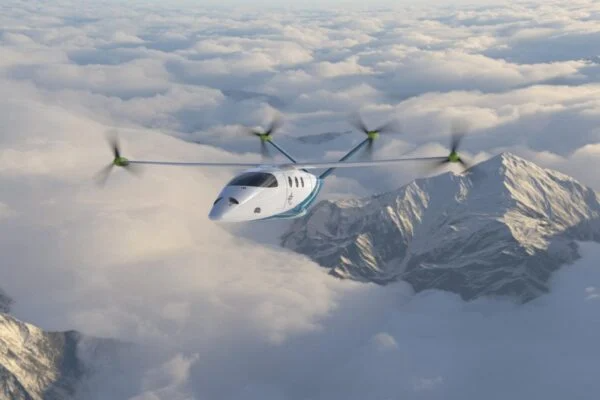Electric drives are not only gaining more and more fans on the roads, but also in aviation. At the Aero trade fair in Friedrichshafen, the German Aerospace Center DLR is showing what could be electrically powered in the air in the future.
From battery-electric gyrocopters for urban air traffic to a hybrid-electric short-haul aircraft with around ten passengers to an electric 50-seater with hydrogen fuel cell propulsion for regional air traffic, DLR is showing concepts and models of how the sustainable flying of tomorrow can take shape. Two newly founded DLR facilities – the Cottbus Institute for Electrified Aviation Propulsion Systems and the Aachen Innovation Centre for Small Aircraft Technologies – will also be present. Overall, DLR researchers assume that electric propulsion systems will be relevant for the foreseeable future, especially for the submarkets of small and regional aircraft.
Thus, the concept of a gyroplane for urban use is also one of the focal points of the DLR exhibits. Gyroplanes are manoeuvrable and can take off and land on very short distances with steep approaches and descents. These are urgently needed characteristics for use in urban areas. In addition, the freely rotating rotor blades eliminate the need for a complex main rotor gearbox as in helicopters, which lowers manufacturing and operating costs. Applications as an air taxi or cargo drone appear attractive. In the S²TOL (Silent Short Takeoff and Landing) research project, a new concept for an extremely quiet and short takeoff-capable aircraft based on a gyroplane is being developed and demonstrated in flight experiments under the leadership of the DLR Institute of Flight Systems Technology as part of the DLR Innovation Centre for Small Aircraft Technologies in cooperation with the Institute of Jet Propulsion and Turbomachinery at RWTH Aachen University.
S²TOL – Quiet take-off and landing for urban mobility
The concept envisages a new gyroplane with two electric drives that are optimised in terms of noise emission. Two configurations with conventional and with shrouded propellers will be compared. Both demonstrators will be flown and virtually tested in the DLR flight simulator. The first flight tests of the variant with open propellers and a take-off weight of around 400 kilograms are planned for 2024. The demonstrator with two electrically driven mantle propellers and an aerodynamically optimised airframe is to be derived from the knowledge gained. The jacketed propellers to be used are being researched at the Institute for Jet Propulsion and Turbomachinery at RWTH in cooperation with Jetpel GmbH. The aim of the project is to evaluate the flight performance, safety and noise emissions in flight tests and to derive new airworthiness requirements with a view to future EASA certification. A 1:6 scale model of the gyroplane configuration will be on display at the DLR stand at AERO.
The “HyBird” concept, which DLR is also exhibiting at AERO, is aimed at use as a feeder aircraft for distances of less than 1000 km. In this aircraft, a gas generator and an electrically driven propeller are intended to reduce costs and emissions. The aim of the concept study is to design a climate-friendly small aircraft in the CS-23 certification category. The aircraft should be able to carry five to nine passengers at least 700 to 1,000 kilometres. Based on the concept developed, the DLR Institute of System Architectures in Aeronautics has built a flying, instrumented test carrier with a maximum weight of 25 kilograms on a scale of 1:4 as part of the DLR Innovation Centre for Small Aircraft Technologies in Aachen together with Airbus ProtoSpace Hamburg. This experimental carrier will be presented for the first time at the fair. Initial flight tests with this demonstrator are planned for the summer to analyse and optimise the aircraft concept. At the end of the project, the design of a climate-friendly small aircraft is to be completed with the aim of subsequently bringing it into use.
Rising CO2 price makes electric commuter aircraft economical
70 passengers, 2000km range: Concept study for climate-friendly flying
On the scale of around 50 passengers, the DLR Institute of Electrified Aerospace Propulsion Systems is using the “H2ELECTRA” model to demonstrate the possibilities for powering an aircraft electrically or even hybrid-electrically in the future with the help of hydrogen and fuel cells. With the help of interchangeable components, different configurations of drive architectures, novel technologies and different integration concepts can be visualised on the model. The model on a scale of 1:10 and with a wingspan of almost three metres illustrates the institute’s holistic systems approach and the many different ways in which regional aircraft can be electrified in the future. At the event in Friedrichshafen, a variant with a fuselage-integrated drive train with all relevant components is installed. It shows technological possibilities and future perspectives for aviation and addresses current core topics of electric flying, its potentials and challenges.
With all these concepts and research activities, DLR intends to contribute to making aviation climate-neutral by the middle of the century, in line with general technological development. The goal is highly efficient, climate-friendly aircraft. These should take off with climate-friendly propulsion concepts and sustainable fuels, depending on their range and size. DLR is positioning itself as a virtual manufacturer (Virtual OEM) with its holistic research competencies. New technologies and fuels, as well as climate-friendly flight management, should further reduce CO2, nitrogen oxide and particle emissions in aviation in the future.



Leave a comment